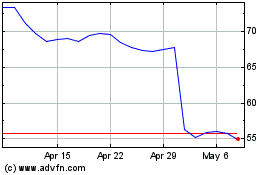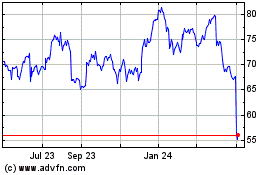By Sharon Terlep and Jaewon Kang
In some towns, it's getting harder to pick up your
blood-pressure pills with that gallon of milk and rotisserie
chicken.
Hundreds of regional grocery stores in cities from Minneapolis
to Seattle are closing or selling pharmacy counters, which have
been struggling as consumers make fewer trips to fill prescriptions
and big drugstore chains tighten their grip on the U.S. market.
Grocery pharmacies are getting hit on several fronts, analysts
and the companies say. They are too small to wrest competitive
reimbursement rates on drugs, they aren't connected to big medical
networks or insurers, and they generally lack walk-in clinics and
other health services that draw many customers to CVS and Walgreens
locations.
"Our establishment had a community feel, it wasn't overly busy
so we got to really care for our customers," said Phillip Breker,
who managed a now-closed pharmacy at Lunds & Byerlys, a
Minneapolis-area grocery chain. "I also saw the numbers in the back
end and how that soured in the last 10 years. The company made the
right decision."
Grocery pharmacies are the latest casualty of industry
consolidation that has for years been forcing mom-and-pop
drugstores to close. Even some big players have rethought the
market. Target Corp. sold off its pharmacy business to CVS Health
Corp. five years ago.
Supermarkets have viewed pharmacies as a tool to draw shoppers
in. Fueled by easy profits and relatively low startup costs,
legions of stores added pharmacy counters in the 1980s and 1990s.
Grocery drugstores proliferated to account for roughly 14% of
retail pharmacy prescriptions, according to the National
Association of Drug Stores.
The number of grocery pharmacies declined for the first time in
years in 2017, the latest year for which data is available, to
9,026, down from 9,344 in 2016.
Consumers are increasingly getting 90-day supplies of their
medicines or getting prescriptions delivered in the mail. Those
trends are resulting in a decline in foot traffic to supermarket
pharmacies, which were typically located at the back of stores.
Meantime, profits are ever harder to come by as the health-care
industry consolidates.
CVS and Walgreens Boots Alliance Inc., the nation's biggest
players, contributed more than 40% of U.S. prescription revenues in
2018, according to Drug Channels Institute, which provides research
on the drug supply chain.
The chains, which now either own or have partnerships with the
biggest insurers and pharmacy-benefit managers, are able to secure
better deals on drug costs that largely shut out the industry's
smaller players. Pharmacy-benefit managers serve insurers and other
clients by choosing which medicines to cover and pushing for lower
prices from drugmakers and sellers.
CVS and Walgreens also are working to transform drugstores into
health-care hubs, offering services from blood testing to
chronic-disease management.
"The biggest companies in health care now have pharmacists and
doctors, they own medical practices, and they own urgent-care
clinics," Baird analyst Eric Coldwell said. Grocery pharmacies
"have none of this. They have a store to go into to buy lemons and
bread."
The tougher conditions come as the entire drugstore industry
copes with a shift to online shopping and shrinking profits in
prescription medicines, which often disproportionately affect
smaller players.
Walgreens and CVS have closed or are closing more than 300
underperforming stores, while Rite Aid Corp., the No. 3 U.S. chain,
is struggling to turn itself around after regulators blocked a
merger with Walgreens in 2017.
Raley's Supermarkets, a West Sacramento, Calif., chain of about
120 stores, last year shut down a third of its roughly 100
pharmacies and transferred prescriptions to nearby Walgreens, CVS
and Rite Aid stores. Those grocery pharmacies had low prescription
rates, were losing money and didn't merit high operating and labor
costs, according to Raley's.
"There is the benefit of having a pharmacy relative to the
grocery-sale lift and the convenience factor of having both in the
store, but the economics do not work," said Keith Knopf, chief
executive of Raley's.
Profitability for grocers has become harder to achieve in recent
years, and pharmacies play a less important role today in
attracting customers, Mr. Knopf said. Raley's is cutting hours for
the remaining pharmacies to improve profits and create efficiency.
Pharmacies make up roughly 20% of Raley's total sales.
Many grocers still view pharmacies as a key part of their
business. Kroger Co., the biggest U.S. supermarket chain, said its
pharmacy business is expected to improve this year after
lower-than-expected profits in 2019. Kroger has said pharmacy
shoppers tend to be more loyal, spending three times as much as
nonpharmacy customers.
"We've been able to connect the relationship with food and are
starting to build out new revenue streams," Kroger finance chief
Gary Millerchip said at an investor meeting in November.
Lunds & Byerlys, the Minnesota chain, shut all 14 of its
supermarket pharmacies last year. At each location, it posted a
sign that has become increasingly common: "The pharmacy is now
closed. Your prescription records have been transferred to
Walgreens."
Mr. Breker, the pharmacy manager, now works for Walgreens at a
location in a nearby town. "I literally cried at the counter with
dozens of people," he said. "They felt a loss here."
Write to Sharon Terlep at sharon.terlep@wsj.com and Jaewon Kang
at jaewon.kang@wsj.com
(END) Dow Jones Newswires
January 26, 2020 05:44 ET (10:44 GMT)
Copyright (c) 2020 Dow Jones & Company, Inc.
CVS Health (NYSE:CVS)
Historical Stock Chart
From Mar 2024 to Apr 2024

CVS Health (NYSE:CVS)
Historical Stock Chart
From Apr 2023 to Apr 2024
